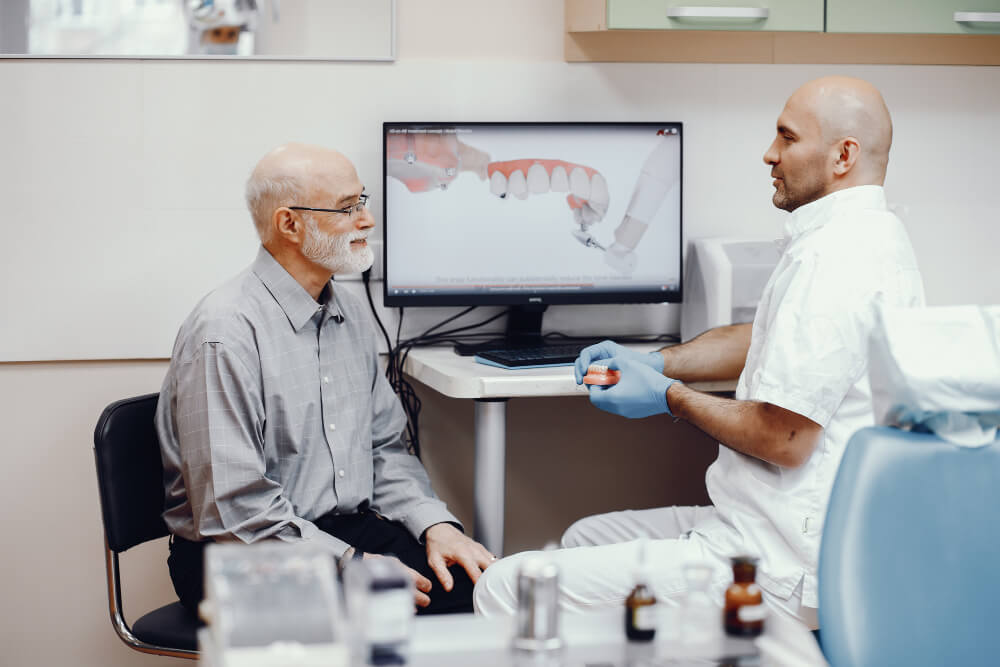
Your smile is one of the most valuable possessions you have, which greatly influences your look and level of self-confidence. However, when one or more teeth are missing, your smile will be incomplete, and you may have difficulties with eating, speaking, and even feeling like yourself. Fortunately, dental technology has come a long way, and restoring your smile has never been easier than with the use of options like bonded dental bridges.
Understanding Bonded Dental Bridges: A Modern Solution for Missing Teeth
A bonded dental bridge, often more commonly referred to as a Maryland bridge, refers to any dental restoration used to replace one or more missing teeth. This is ideal for those patients who want to replace just a single tooth or a few teeth, especially in the front of the mouth. Unlike other traditional bridges, bonded dental bridges are held in place by a metal or porcelain framework bonded onto the back of the adjacent teeth, rather than crowns on top of adjacent teeth. The procedure is less invasive, and the natural tooth structure is well preserved; hence, it appeals to a number of patients.
Some of the advantages of bonded dental bridges are:
- Minimally Invasive: The treatment does very little damage to the surrounding teeth as most of your natural tooth structure is preserved.
- Aesthetic: The bridge is shaded such that it has a color, shape, and size which exactly resembles that of your natural teeth; hence, giving it a flawless look.
- Durability: Bonded dental bridges can serve for many years with good care taken hence it might be a long-term option for missing teeth.
- Functionality: Bonded bridges make the dentition functional by allowing you to chew food and speak without any hesitation.
- Comfort: Custom-made to fit your mouth, a bridge doesn’t irritate the mouth or cause discomfort of any kind.
Step 1: Consultation with a Dentist, Mt Vernon, NY
The journey to a bonded dental bridge begins with a consultation with a competent Dentist at Mt Vernon, NY. This is very important because this will be an opportunity for the dentist to examine your mouth to ensure that a bonded dental bridge is what you need. This consultation will involve a comprehensive examination of the mouth, including the teeth, gums, and jawbone.
First Consultation: What to Expect?
- Oral Check-up: The dentist clinically examines your teeth and gums. This will help in finding any potential decay, gum diseases, or other problems within your oral cavity that need to be treated before placing the bridge.
- X-rays and scans: X-rays or digital scans are taken to give a detailed view of the potential area in which the bridge will be fitted. This is an important initial step in the planning of the placement and also in making sure that the adjacent teeth are healthy enough to support the bridge.
- Discussion of Options: The dentist will describe options for different kinds of bridges and tell you why a bonded dental bridge is suitable for you. All your questions about the procedure will be answered by them.
Step 2: Personalized Treatment Planning
Once the consultation is done and your dentist feels that you are a suitable candidate for a bonded dental bridge, a treatment plan needs to be worked out. The preparation of a treatment plan is always individually designed, considering the unique needs and wants of each patient to achieve the desired outcome of the procedure.
Key Components of the Treatment Plan:
- Material selection: You and your dentist will have to decide first on the material to be used for the bridge. Some of the materials used to make bonded dental bridges are metal alloys, porcelain, and sometimes a combination of both. All these factors also are being considered during the selection of a material: location of the missing tooth, the bite, and aesthetic preference.
- Design and Esthetics: Your dentist will discuss the suitable color, shape, and size of the bridge. They do this with a goal of constructing a bridge that will appear as natural as possible and blend into other teeth.
- Digital Imaging: Advanced digital imaging technology, we are able to design your bridge with precision. This technology helps us create a virtual model of the mouth to help design a bridge that perfectly fits and looks natural. We can also provide you with a preview of how your new smile will look before the bridge is even fabricated.
Step 3: Adjacent Tooth Preparation
Once the treatment plan is done, the next step would include the preparation of the adjacent teeth. Preparation of the teeth ensures that the bridge anchors safely and functions properly.
What Does a Tooth Preparation Entail:
- Minimum tooth alteration: The major advantages of a bonded dental bridge are that this type requires only minimum alteration of the adjacent teeth. Your dentist will lightly etch the back surfaces of the teeth next to the missing tooth. This means a rough surface is created on the back of these teeth to improve bonding of the bridge.
- Preservation of Tooth Structure: Unlike most conventional bridges, which need to reshape the adjacent teeth seriously for supporting crowns, bonded bridges conserve more of the tooth structure. This is significant in maintaining health and integrity for a longer period.
This is accomplished precisely, taking care of the prepared teeth so that they may support the bridge without affecting their health.
Step 4: Taking an Impression for the Custom Bridge
After preparation of the adjacent teeth, a dentist takes an impression of the mouth. These impressions will help in the fabrication of a perfectly fitting bridge, which will give rise to snugness and comfort.
Impression Techniques:
- Traditional Impressions: The more traditional way is by impression where dental putty is applied to record the impression of teeth. The putty is put inside a tray and pressed onto the patient’s request to bite to make the dentition of teeth and gums. The technique is effective, though a little discomforting for some patients.
- Digital Impressions: prefer to use digital scanning technology when taking impressions. Digital scans are much more comfortable for the patient and very accurate. A highly detailed three-dimensional image is taken of the mouth during the scan, which is used in creating an accurate model to fabricate your bridge.
These impressions or scans are then sent to a dental laboratory where skilled technicians will actually fabricate your bonded dental bridge. This may take a couple of weeks and your dentist may place a temporary bridge so as not to leave the teeth that were prepared and also not to affect the aesthetics of the smile while waiting for your custom-made bonded dental bridge.
Step 5: Fabrication of Custom Bonded Dental Bridge
Once impressions are sent to the dental laboratory, the fabrication of your custom bonded dental bridge starts. This is an important stage in ensuring the good fit and aesthetics of the bridge.
Steps in the Fabrication Process:
- Fabrication of the Framework: The work that starts in the laboratory is the fabrication of the framework of the bridge. Based on the treatment plan that you and your dentist have discussed, the framework is generally fabricated from an alloy or porcelain. It is designed to fit snugly against the back of the adjacent teeth while supporting the replacement tooth or teeth.
- Attaching the Replacement Tooth: After the framework is attached, the laboratory technician attaches a replacement tooth or teeth to the bridge. It is fabricated in shape, color, and size to your natural teeth to provide the best blend with your remaining teeth.
- Quality Control: The bridge, before it is returned to your dentist, will undergo strict quality control at the laboratory to ensure that indeed the highest standards of fit, function, and aesthetics are realized.
Step 6: Cementing the Custom Dental Bridge
Once your custom dental bridge is prepared, you will head back to your dentist’s office for the final placement. One careful step in the process that requires precision for a strong and long-lasting bond is bonding.
The Bonding Process:
- Try-in: Your dentist will try on the bridge, without cementing first to make sure of its proper fit and appearance. This way, some adjustments can be done to perfectly align it with your bite and make sure that it does look natural.
- Preparation of the Surfaces: The dentist will again prepare the surfaces of the adjacent teeth; cleaning and conditioning to enhance bonding. This includes applying a mild acid solution to the surface, which gives the surface a slightly rough texture to allow the material and environment to bond better.
- Attaching the Bonding Material: The dentist will apply special dental adhesive to each of the etched surfaces on the adjacent teeth. He or she then carefully positions the bridge in place. The dentist will make sure it is properly aligned and then uses a curing light to harden the adhesive.
- Final Adjustments: After the bridge is cemented in place, your dentist will make any final adjustments to ensure that your bite is comfortable and that the bridge looks and feels natural.
This is the step that concludes the placement process but basically covers the beginning of your new smile. With the bridge securely attached in place, you will make full use of your restored smile and functional dentition.
Step 7: Post-Procedure Care
After your bonded dental bridge is in place, it is essential to take proper care of it to ensure longevity and maintain oral health. Here are a few post-procedure care tips:
- Oral Hygiene: Maintaining good oral hygiene is essential. Brush your teeth twice daily, floss daily, and use an antibacterial mouthwash. Regular flossing under the bridge is necessary to prevent plaque buildup and ensure the health of the surrounding gums.
- Regular Dental Visits: Regular dental visits to your Dentist in Mt Vernon, NY, for cleanings and check-ups will help keep the bridge and surrounding teeth in good shape. These visits also allow your dentist to monitor the bridge and its fit over time.
- Avoid Hard Foods: Avoid chewing hard foods or using your teeth as tools to prevent any damage to the bridge.
Conclusion
A bonded dental bridge is a modern and effective solution for restoring missing teeth with minimal alteration to the adjacent teeth. It offers both functionality and aesthetic appeal, allowing you to enjoy a natural-looking smile while confidently eating and speaking. If you’re considering a bonded dental bridge, it’s essential to consult with a skilled dentist to determine if it’s the right option for you.
At Aurora Smiles NY, Dr. Amul Patel and his team are committed to delivering exceptional dental care and creating beautiful, healthy smiles for our patients. Contact us today to schedule a consultation with Dr. Amul Patel and discover how we can help you achieve the smile you’ve always wanted!
